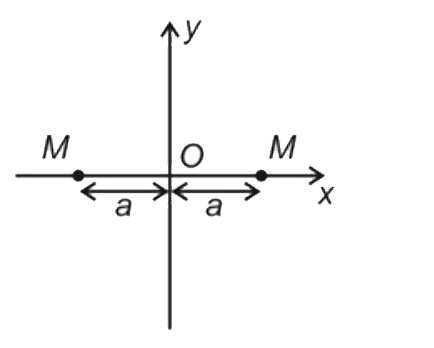There are two fixed heavy masses of magnitude M of high density at a distance 2d apart. On the axis, a small mass m moves in a circle of radius R in the y−z plane between the heavy masses. Find the velocity of the small particle.
To find the velocity of the small mass m moving in a circular path between two fixed heavy masses M at a distance 2d apart, we can follow these steps:
Step 1: Understanding the Setup
We have two heavy masses M located at points (−d,0,0) and (d,0,0). The small mass m is moving in a circular path of radius R in the y−z plane. The gravitational force between the small mass m and each of the heavy masses M will provide the necessary centripetal force for circular motion.
Step 2: Calculate the Gravitational Force
The gravitational force F between each mass M and the small mass m can be given by Newton's law of gravitation:
F=GMmr2
where r is the distance from the mass m to the mass M. For the small mass m, the distance to each mass M can be calculated using the Pythagorean theorem:
r=√d2+R2
Thus, the gravitational force exerted by one mass M on m becomes:
F=GMmd2+R2
Step 3: Net Gravitational Force on the Small Mass
Since there are two masses M exerting gravitational force on m, the net force acting on m in the downward direction (towards the center of the circular path) is:
Fnet=2Fcos(θ)
where θ is the angle between the line connecting m to M and the vertical axis. By symmetry, cos(θ) can be expressed as:
cos(θ)=R√d2+R2
Thus, the net gravitational force becomes:
Fnet=2(GMmd2+R2)R√d2+R2=2GMmR(d2+R2)3/2
Step 4: Centripetal Force Requirement
For circular motion, the centripetal force required is given by:
Fcentripetal=mv2R
where v is the velocity of the small mass m.
Step 5: Setting Forces Equal
Since the net gravitational force provides the centripetal force, we can set them equal:
mv2R=2GMmR(d2+R2)3/2
Cancelling m from both sides (assuming m≠0):
v2R=2GMR(d2+R2)3/2
Step 6: Solve for Velocity
Multiplying both sides by R:
v2=2GMR2(d2+R2)3/2
Taking the square root gives:
v=√2GMR2(d2+R2)3/2
Final Expression
Thus, the velocity of the small mass m is:
v=R√2GM(d2+R2)3/2
We have two heavy masses M located at points (−d,0,0) and (d,0,0). The small mass m is moving in a circular path of radius R in the y−z plane. The gravitational force between the small mass m and each of the heavy masses M will provide the necessary centripetal force for circular motion.
The gravitational force F between each mass M and the small mass m can be given by Newton's law of gravitation:
F=GMmr2
where r is the distance from the mass m to the mass M. For the small mass m, the distance to each mass M can be calculated using the Pythagorean theorem:
r=√d2+R2
Thus, the gravitational force exerted by one mass M on m becomes:
F=GMmd2+R2
Since there are two masses M exerting gravitational force on m, the net force acting on m in the downward direction (towards the center of the circular path) is:
Fnet=2Fcos(θ)
where θ is the angle between the line connecting m to M and the vertical axis. By symmetry, cos(θ) can be expressed as:
cos(θ)=R√d2+R2
Thus, the net gravitational force becomes:
Fnet=2(GMmd2+R2)R√d2+R2=2GMmR(d2+R2)3/2
For circular motion, the centripetal force required is given by:
Fcentripetal=mv2R
where v is the velocity of the small mass m.
Since the net gravitational force provides the centripetal force, we can set them equal:
mv2R=2GMmR(d2+R2)3/2
Cancelling m from both sides (assuming m≠0):
v2R=2GMR(d2+R2)3/2
Multiplying both sides by R:
v2=2GMR2(d2+R2)3/2
Taking the square root gives:
v=√2GMR2(d2+R2)3/2
Thus, the velocity of the small mass m is:
v=R√2GM(d2+R2)3/2
Similar Questions
Four particles of equal masses M move along a circle of radius R under the action of their mutual gravitational attraction. Find the speed of each particle.
View Solution_S01_003_Q01.png)
Two particles of equal mass (m) each move in a circle of radius (r) under the action of their mutual gravitational attraction find the speed of each particle.
View SolutionTwo particles of equal mass m0 are moving round a circle of radius r due to their mutual gravitational interaction. Find the time period of each particle.
View SolutionCentripetal acceleration of a particle of mass m moving in a circle of radius r is 4/r2. What is the angular momentum of the particle ?
View SolutionTwo point masses M are kept fixed on the x-axis at a distance a from the origin, another point mass m is moving in a circular path of radius R (in y - z plane) under the influence of gravitational force of attraction, then speed of m will be (Assume no forces are acting on m other than the gravitational forces by two M)

View SolutionA particle of mass m describes a circle of radius r . The centripetal acceleration of the particle is 4r2 . What will be the momentum of the particle ?
View SolutionTwo bodies of mass M and 4M kept at a distance y apart. Where should a small particle of mass m be placed from M so that the net gravitational force on it is zero
View SolutionTwo particles of mass M and 2M are at a distance D apart. Under their mutual force of attraction they start moving towards each other. The acceleration of their centre of mass when they are D/2 apart is :
View SolutionIf a particle of mass m is moving in a horizontal circle of radius r with a centripetal force (−1/r2) , the total energy is
View SolutionA particle of mass M is revolving along a circule of radius R and nother particle of mass m is recolving in a circle of radius r. If time periods of both particles are same, then the ratio of their angular velocities is
View Solution
